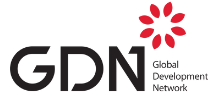
How to maintain freedom and non-bias in research findings; how to stimulate both local funding of southern research and appetite for its findings; and whether it’s possible to avoid the negative aspects of donor-driven research were all topics explored in GDN’s first global webinar hosted by Research To Action on the 18th May 2016.
Convened as part of GDN’s Doing Research program, the webinar focused on the question “Why does the research environment matter?”. The event brought together researchers from across the project including Rahmane Idrissa, a Nigerien political scientist and founder of the Think Tank EPGA, and Courtney Work a Postdoctoral Research Fellow with a joint appointment at the Institute of Social Studies in The Hague and the Regional Center for Sustainable Development at Chiangmai University, Thailand.
Doing Research is an important program for GDN – and to the global research community – as it tackles the thorny issue of how to effectively assess the process of conducing and using social science research in developing countries. Bibliometrics, altmetrics and webometrics are all helpful, but ineffective in capturing a comprehensive picture of the factors shaping the research environment. The Doing Research program sets out to develop an assessment tool which looks at the other end of the spectrum, namely the systems which enable or prevent the production and use of good quality research as well as the environmental factors that influence the organisation of social science research – quality quantity and social relevance. In so doing, it supports GDN’s central vision of strengthening capacities in the Global South to produce academic research in social science and to inform locally-owned development policies.
Speaking from GDN headquarters in Delhi, Clément Gévaudan, Senior Programme Associate of the Doing Research program, presented the pilot phase of the program which included seven research teams across eleven very different countries and research contexts. Clément highlighted that some key questions had guided thinking throughout the program thus far:
- What is a performing research environment?
- What are the relevant dimensions to analyse?
- What are the criteria which help measure and assess performance for each of these dimensions?
He emphasised the importance of developing a community of practice who would contribute to the process of developing the tool and encouraged attendees to speak out during the webinar on what they felt were the most strategic aspects of the research environment and what they considered to be the desired objective of any in-depth analysis in this area.
He iterated the importance of discussions of this type, with a broad group of stakeholders. The discussion is set to continue in order to build a bank of insights as the program moves towards its next phase, the development of a methodology to systematically assess the research environment in social sciences[1].
Rahmane Idrissa and Courtney Work presented findings from the Doing Research pilot case studies in Niger and Cambodia respectively.
Rahmane explained that to make sense of the situation of social science in Niger, his team had approached it historically, looking back at the crisis of the 1990s where research quality fell dramatically and research agendas were driven by international donors, and identifying the impact of reforms which arose from this period. His findings from this study are discussed more extensively in his blog: ‘Social science research and the demand factor in a low-income country – The case of Niger’. He identified the need to diversify research demand – specifically the need to change the structure of demand. He highlighted that research incentives should be more closely linked to social utility instead of focusing on career or profit (which are currently entrenched).
Courtney Work highlighted the profound disconnect between government interests and those of researchers on the ground. While the government is interested in business, agriculture, increased profitability and production, researchers were more interested in social problems – increasing social wellbeing and improving social systems. In accordance with Rahmane, she referred to the potential detrimental impact of being forced to subscribe to donor objectives.
Key themes
Participants quizzed both the presenters, and other listeners during the webinar. Tatum Street asked the panellists to identify the top 2-3 factors that enable the research environment across developing countries. Courtney emphasised the benefits of independence from donor agendas as an enabling factor in Cambodia, as well as outlining the positive impact of working in local languages when publishing and disseminating research findings at a local level.
Rahmane identified similar issues, focussing particularly on the influence of donor demand on the training practices of research students. He said that when the main motivation is securing funding from donors, students are understandably most interested in learning the skills and abilities needed as consultants rather than as researchers. He again referred to a need to diversify sources of demand.
Jean Baptiste Habyarimana asked how to generate local capacity and commitment to fund research in a way that stimulates both a local research agenda and a demand for the findings. The panellists agreed that the academic environments of their respective focus countries were not conducive to public engagement and that this needed to change in order to bring academic knowledge into the public space. This, they argued, would lead to more collaborative practice between Civil Society Organisations (CSOs) and Higher Education institutions and thereby maximise limited resources and create a more socially relevant research agenda.
Ramona Angelescu Naqvi, Director of Programs at GDN provided an important counter argument to the consensus, explaining that findings from the pilot phase of the Doing Research program pointed to the adverse effects of local government led research. These include bias in budget allocation which often prevails; with funds earmarked for technocratic research, or, often, with research commissioned to demonstrate that specific government policies are well-designed and work well. She pointed out that there were still questions here on how to maintain freedom and non-bias in research findings. Ramona also highlighted that the Doing Research program is looking at factors at a macro level (socio economic, political stability, policy frameworks, funding mechanisms etc.) and at a meso level (think tanks, universities etc.) and how they influence and incentivise individual researchers.
Olufemi Oshinowo asked whether a link existed between research findings uptake and the political environment of a nation. Ramona responded that this is highly dependent on where in the world you are referring to. She used Latin America as an example of a region where there is a dynamic culture of engagement between academics, Civil Society Organisations and policymakers. She pointed out that a ‘revolving door’ existed between CSOs and government and that this movement fostered greater engagement. However, she also highlighted the fragility of these relationships in politically unstable environments.
A longer version of this post originally appeared on the Research to Action website. See the full blog here.






